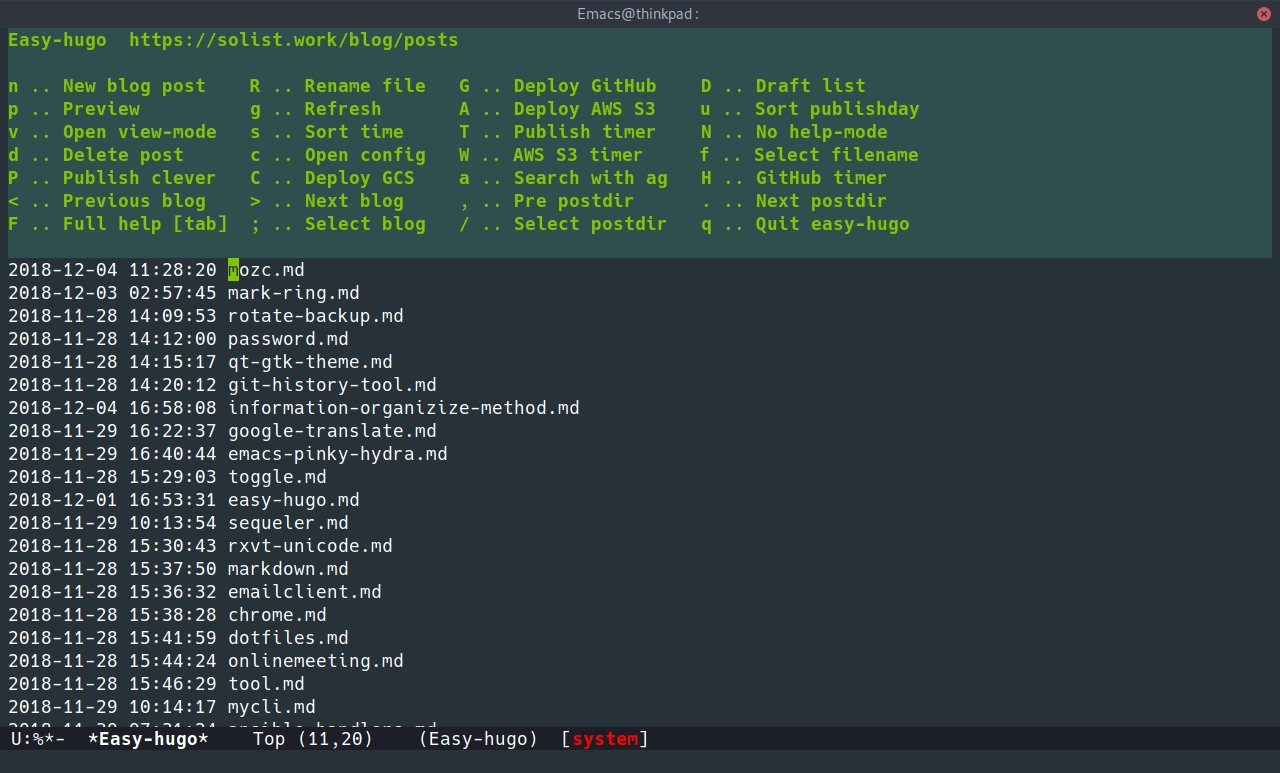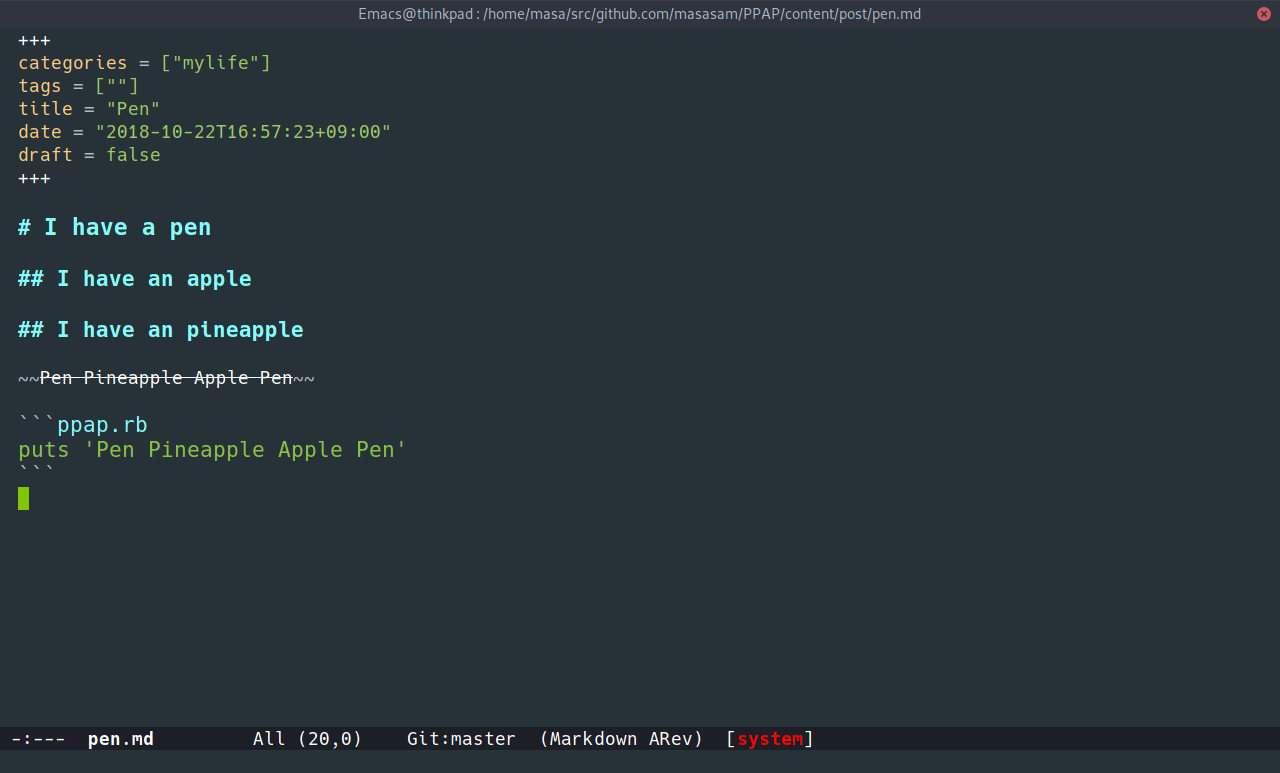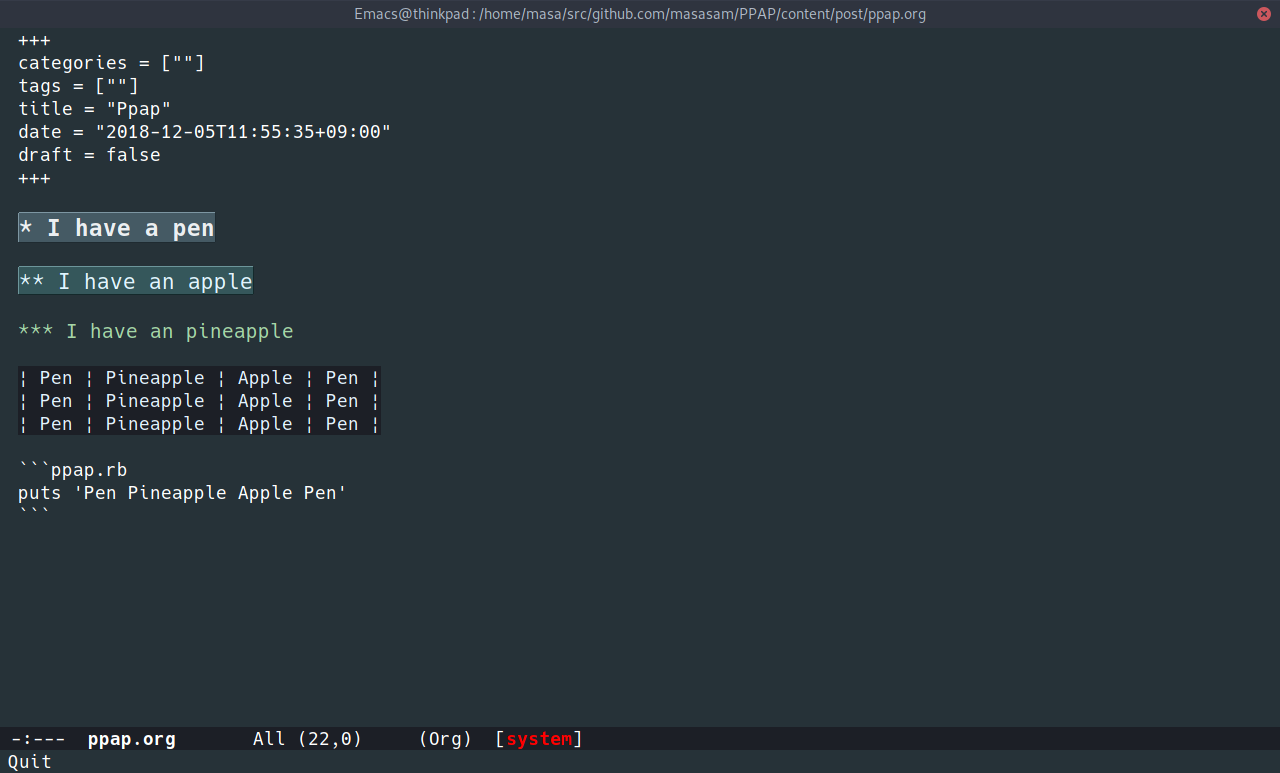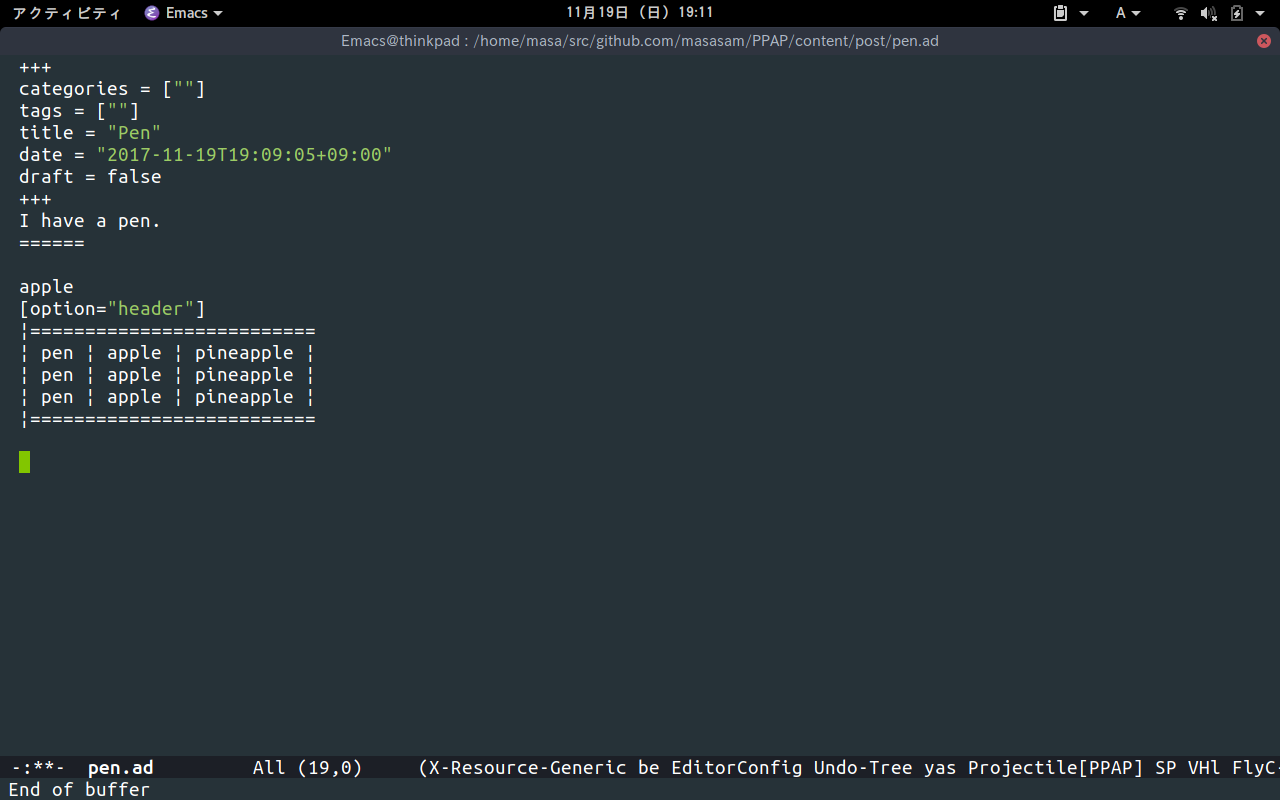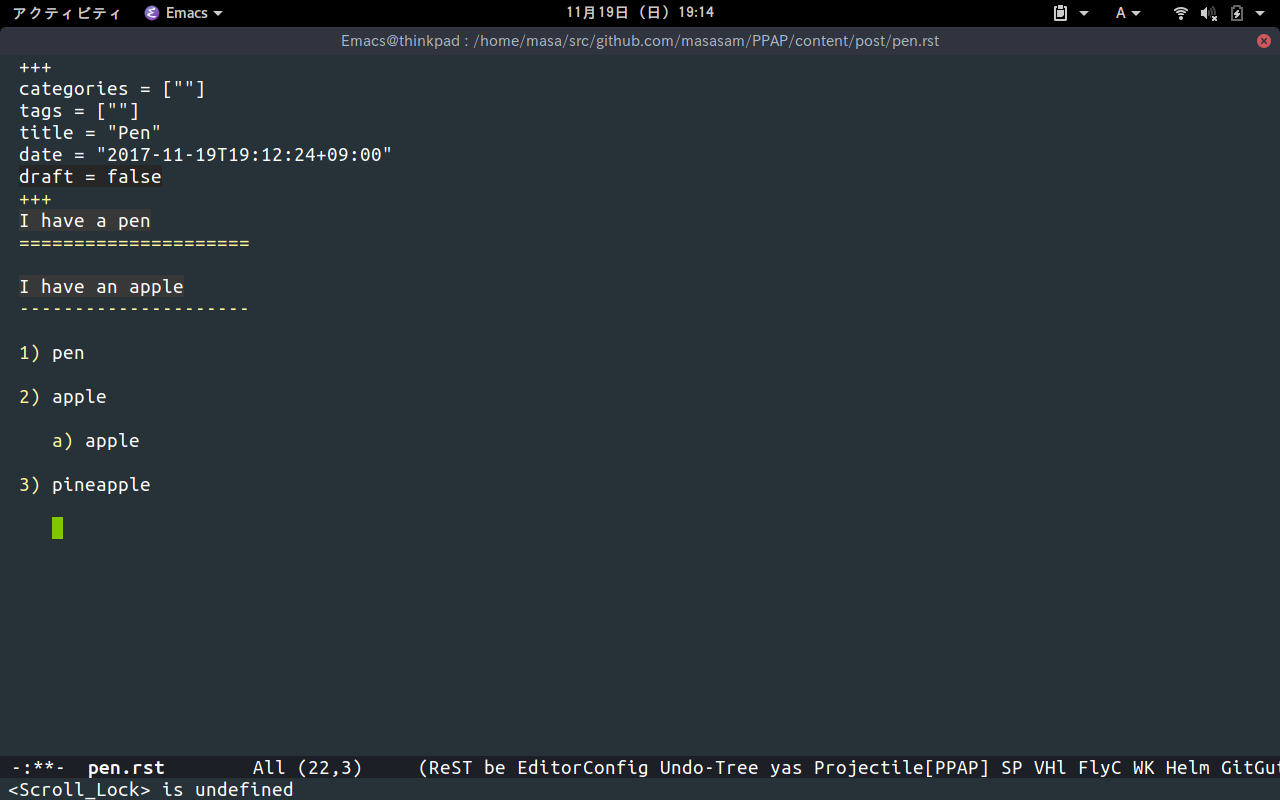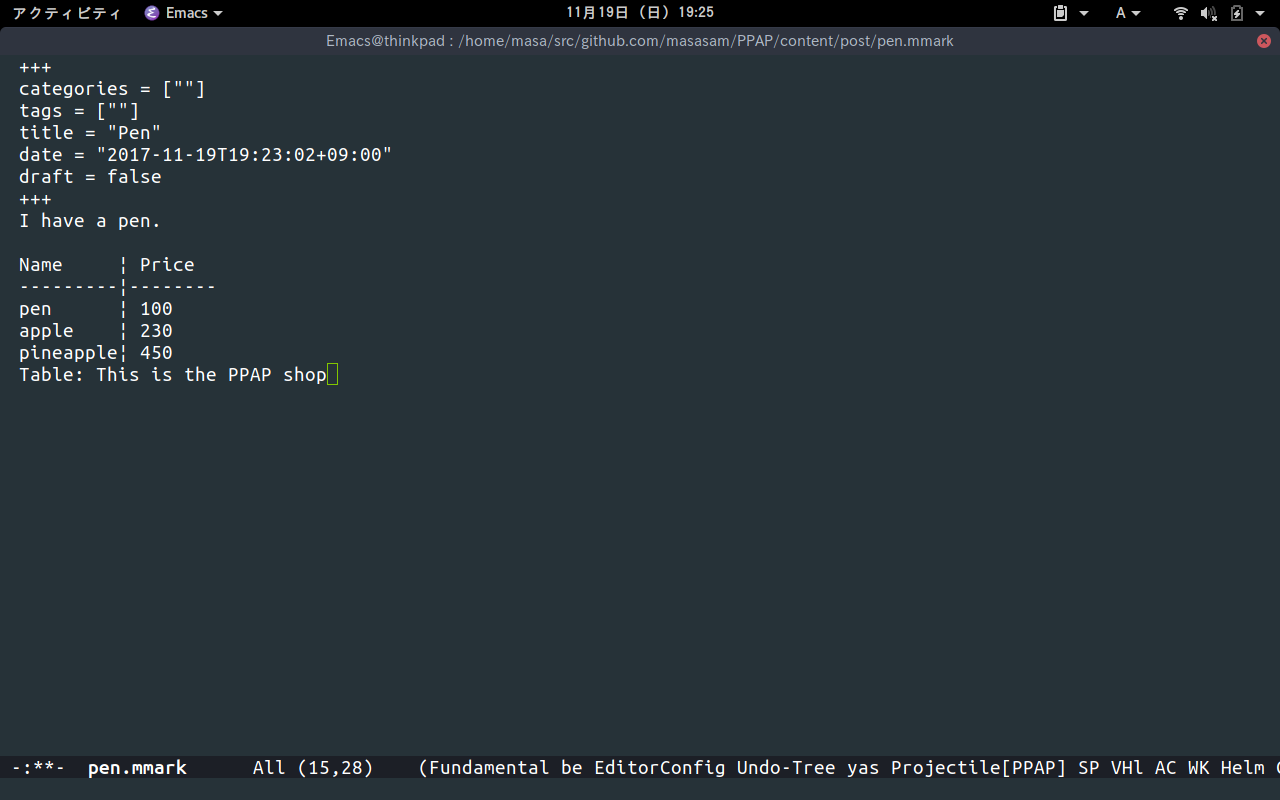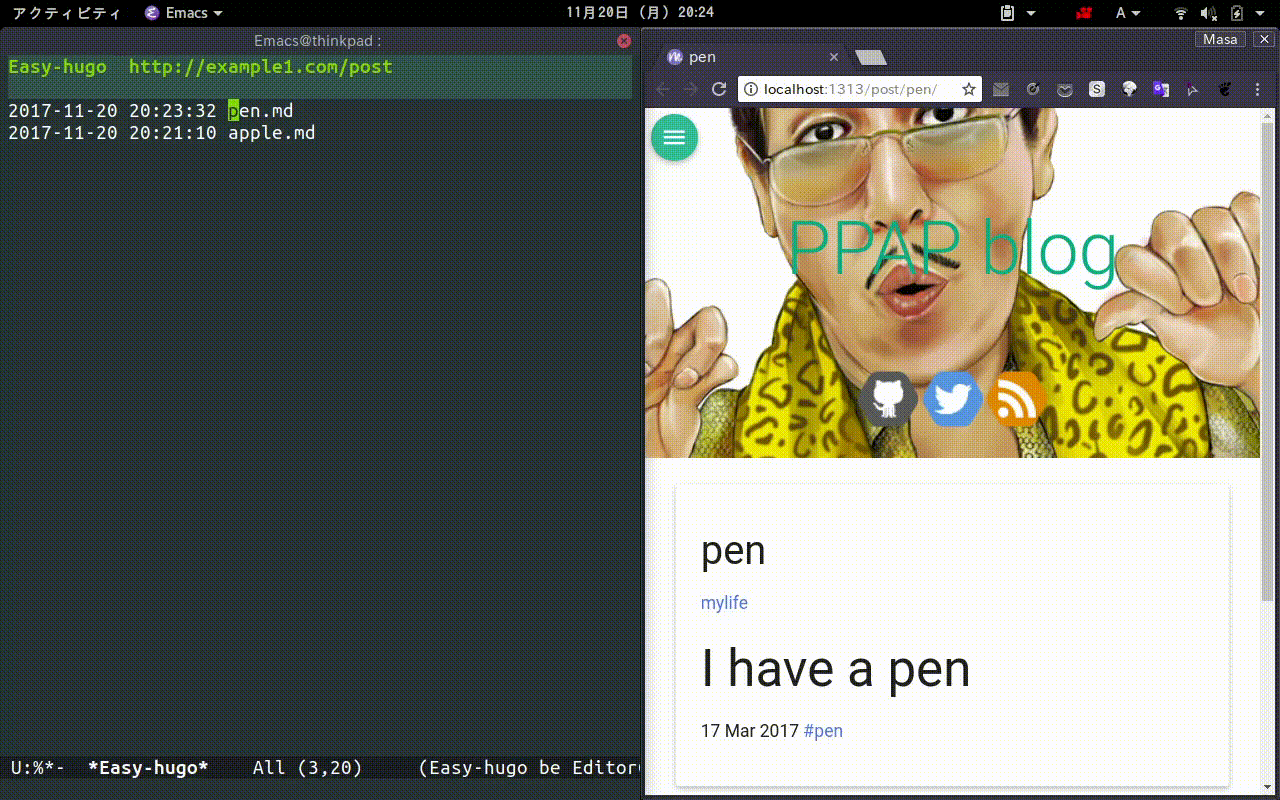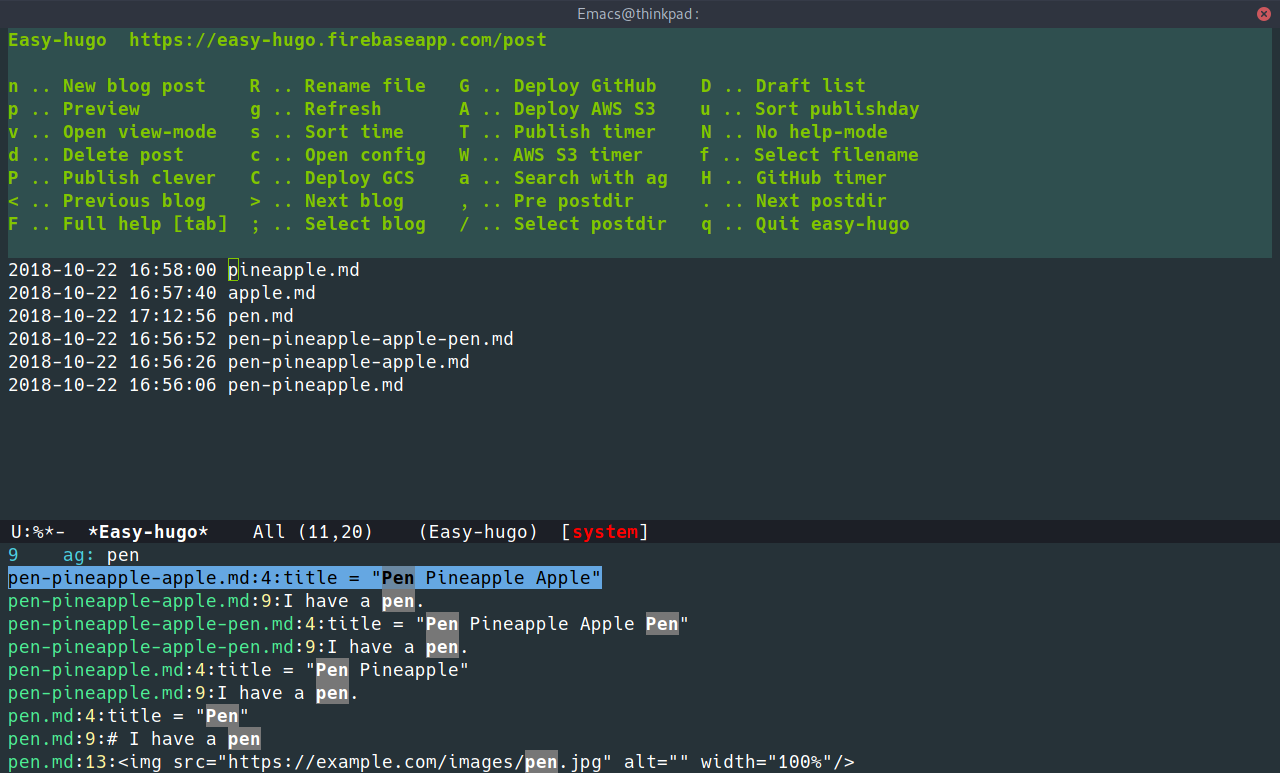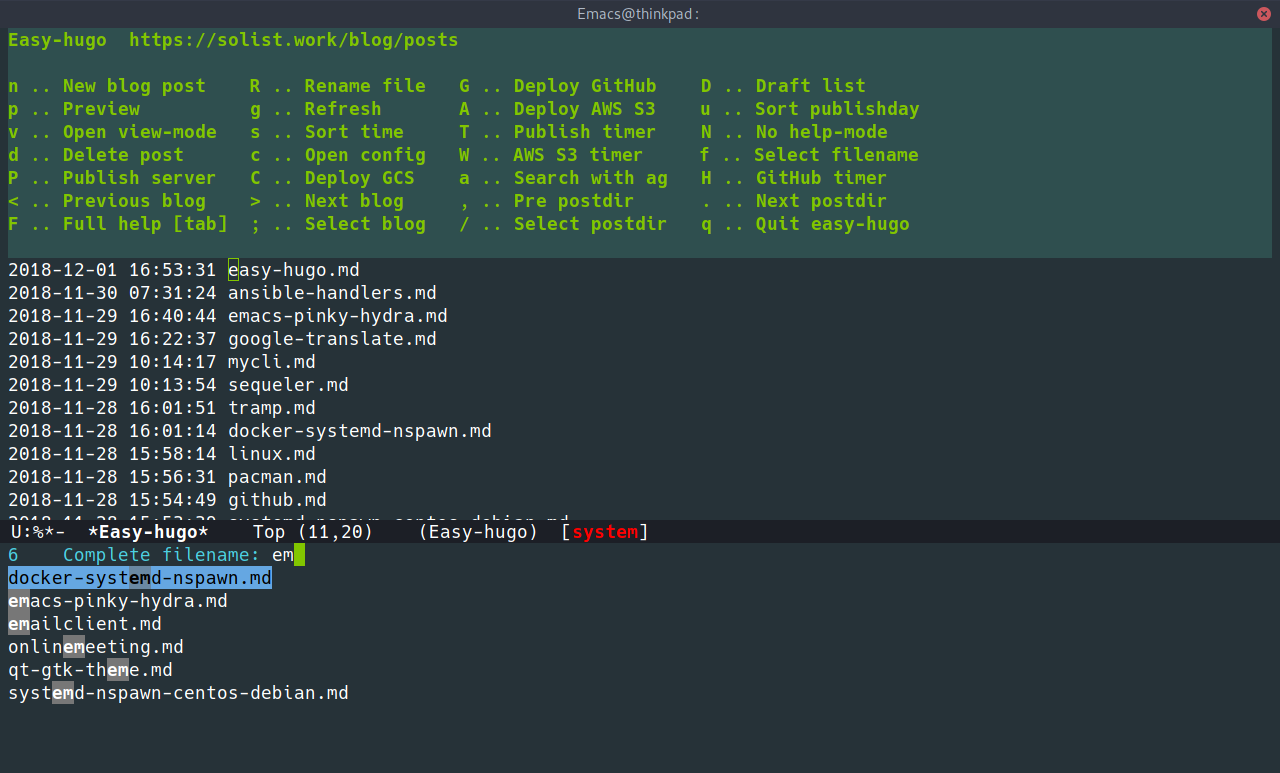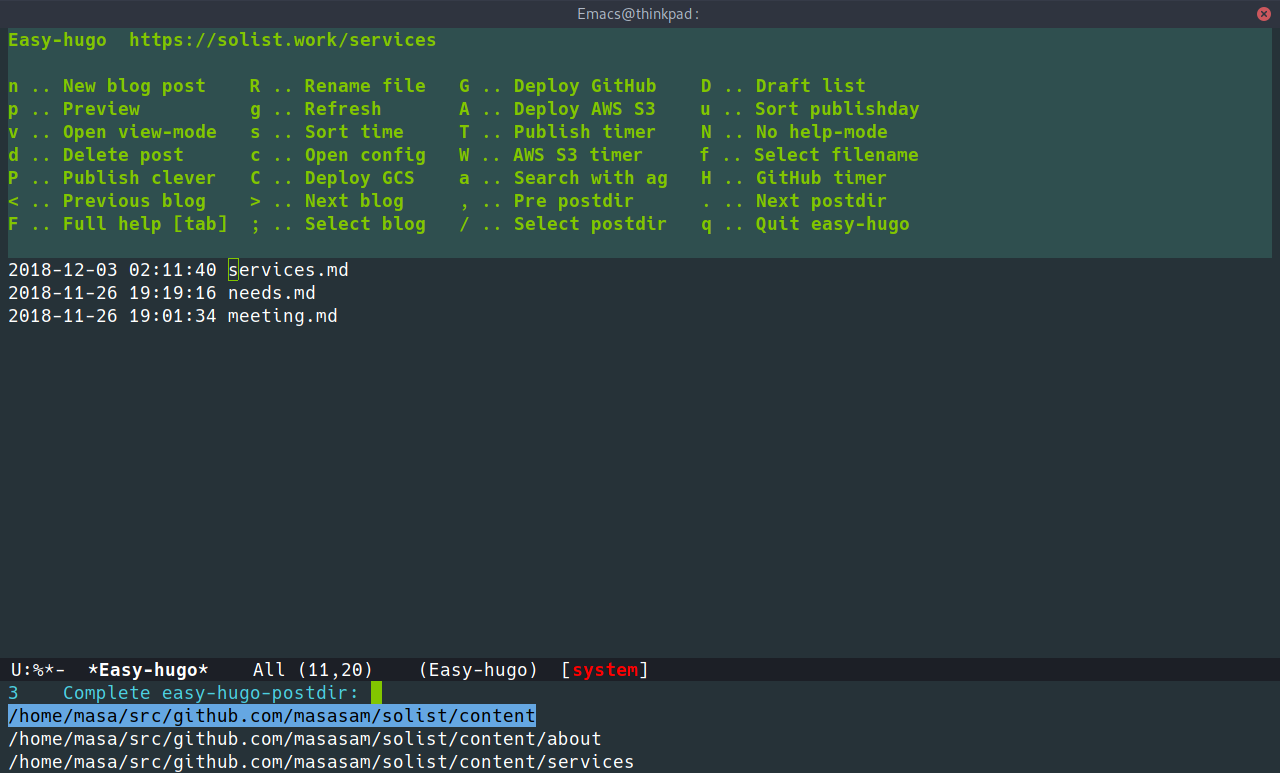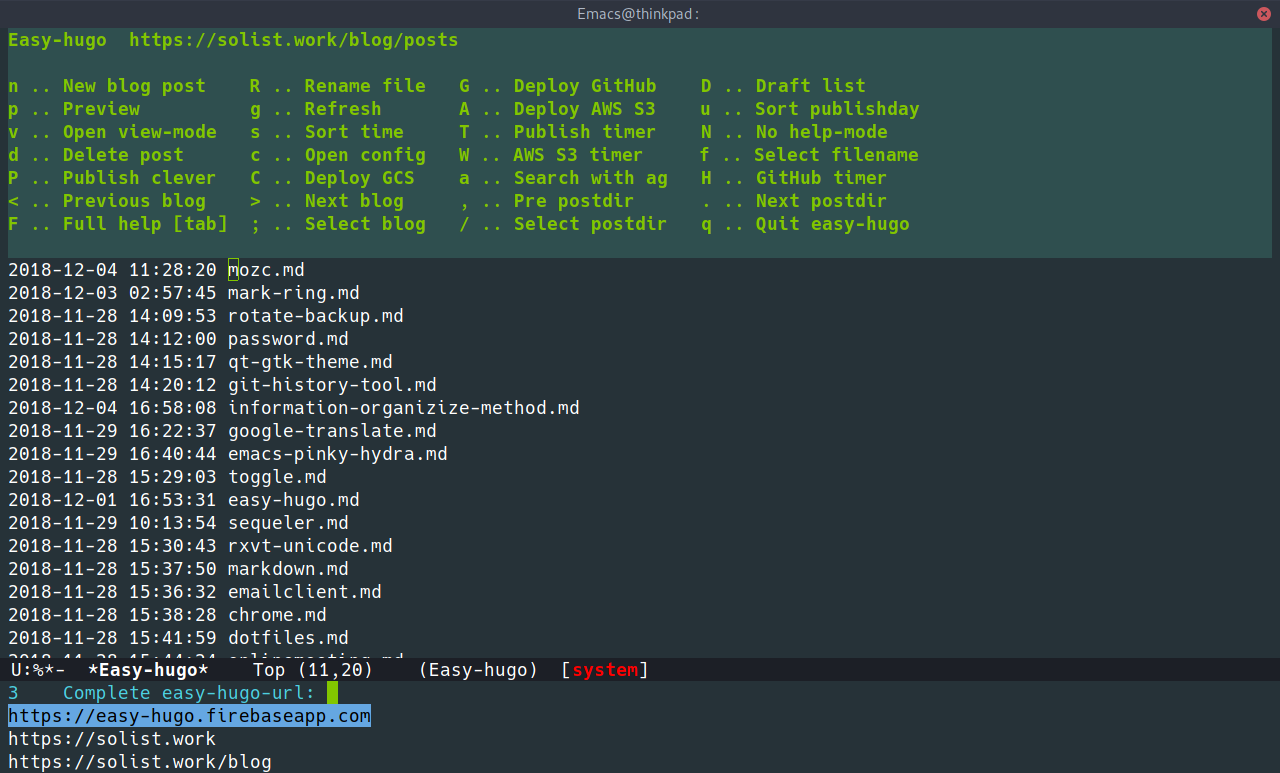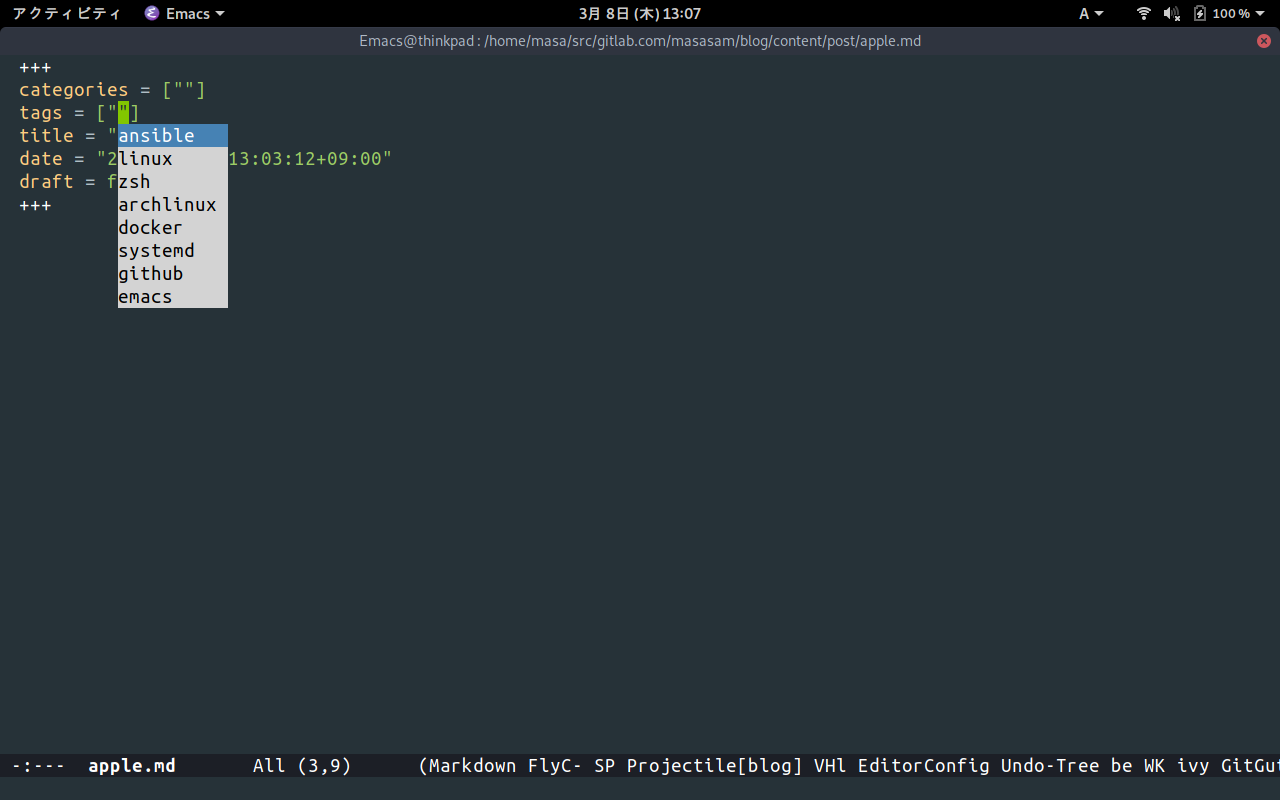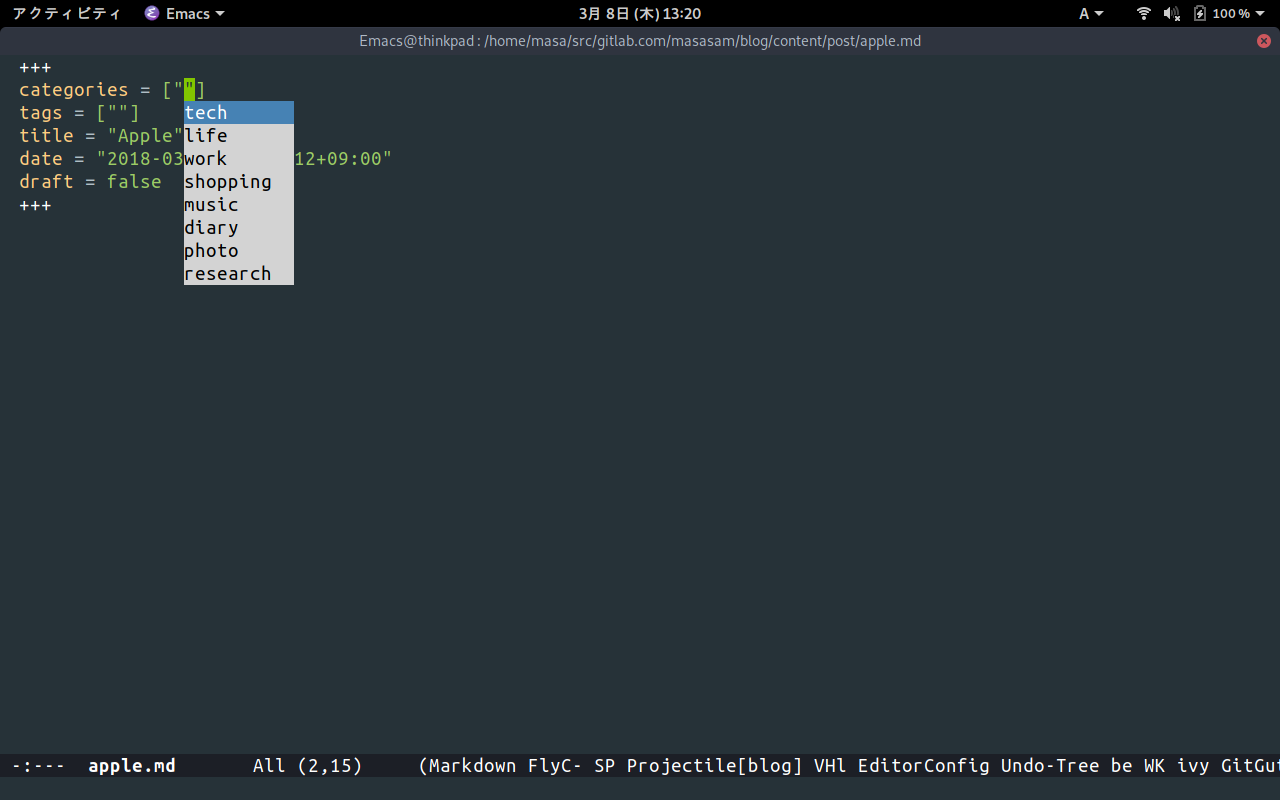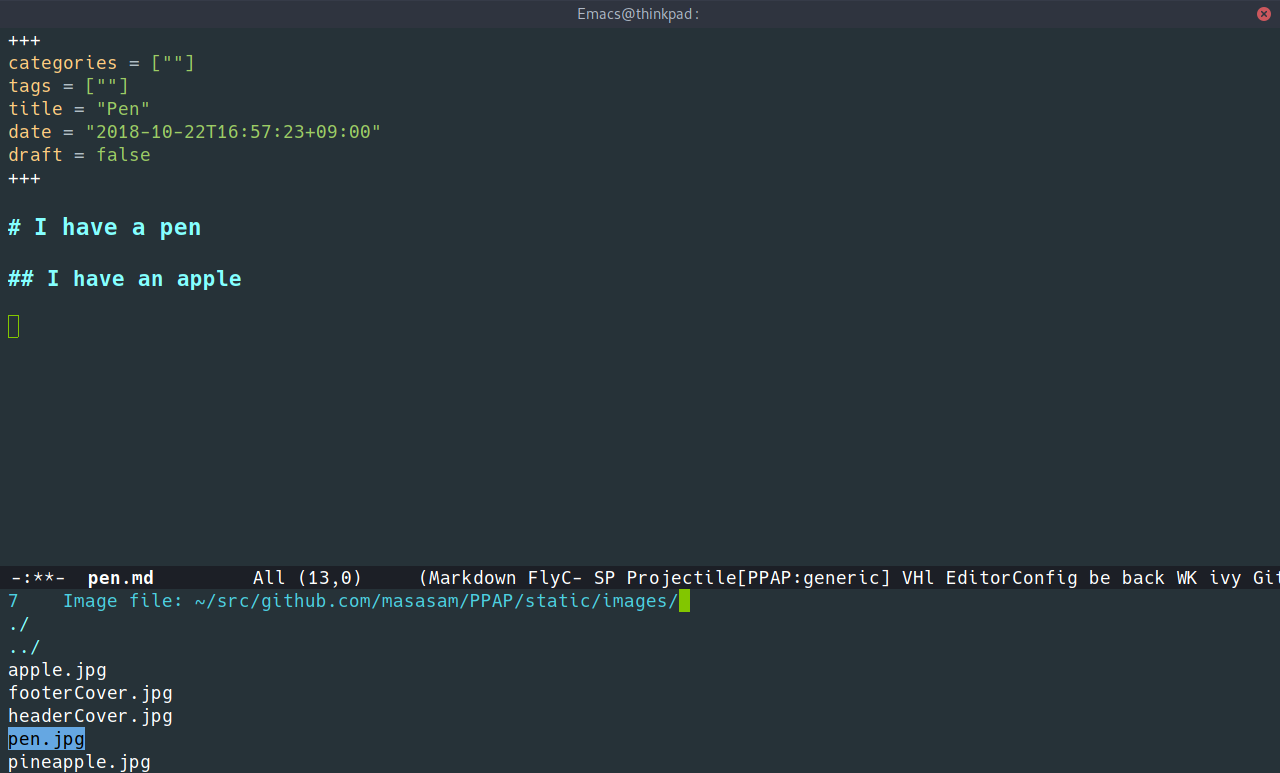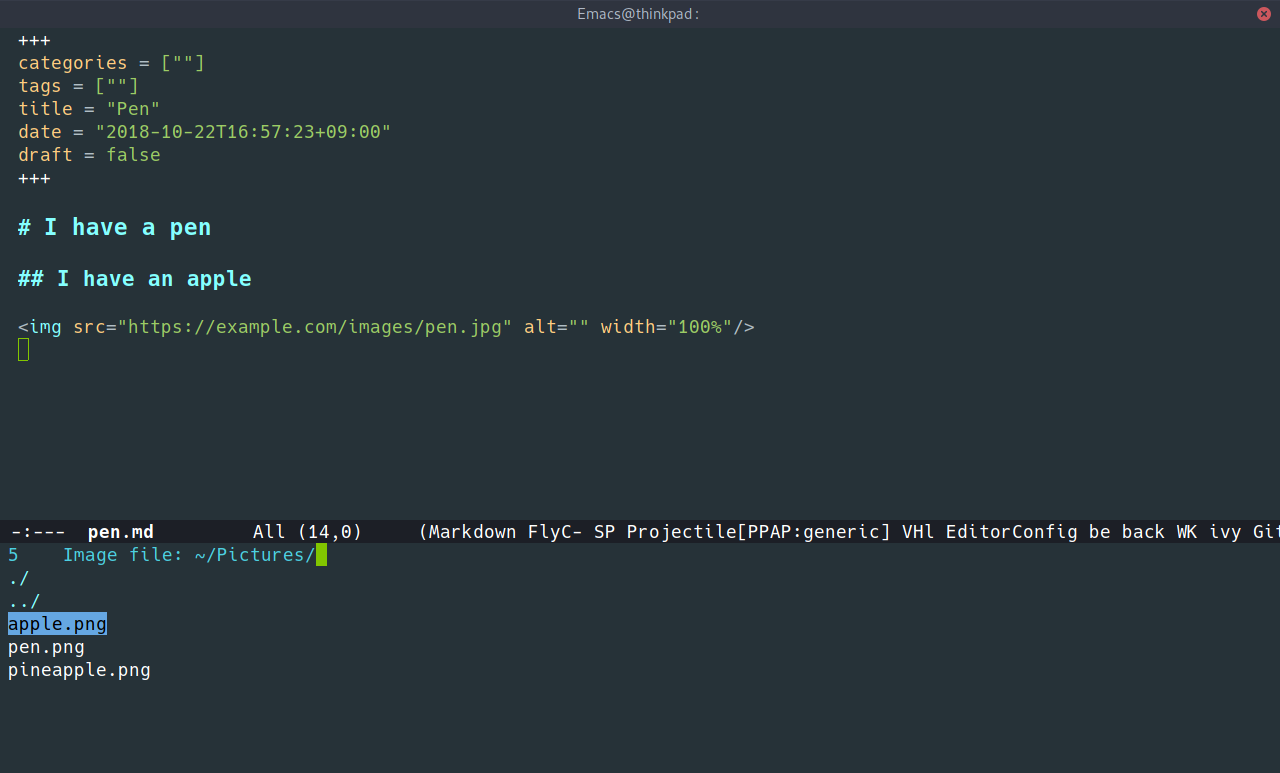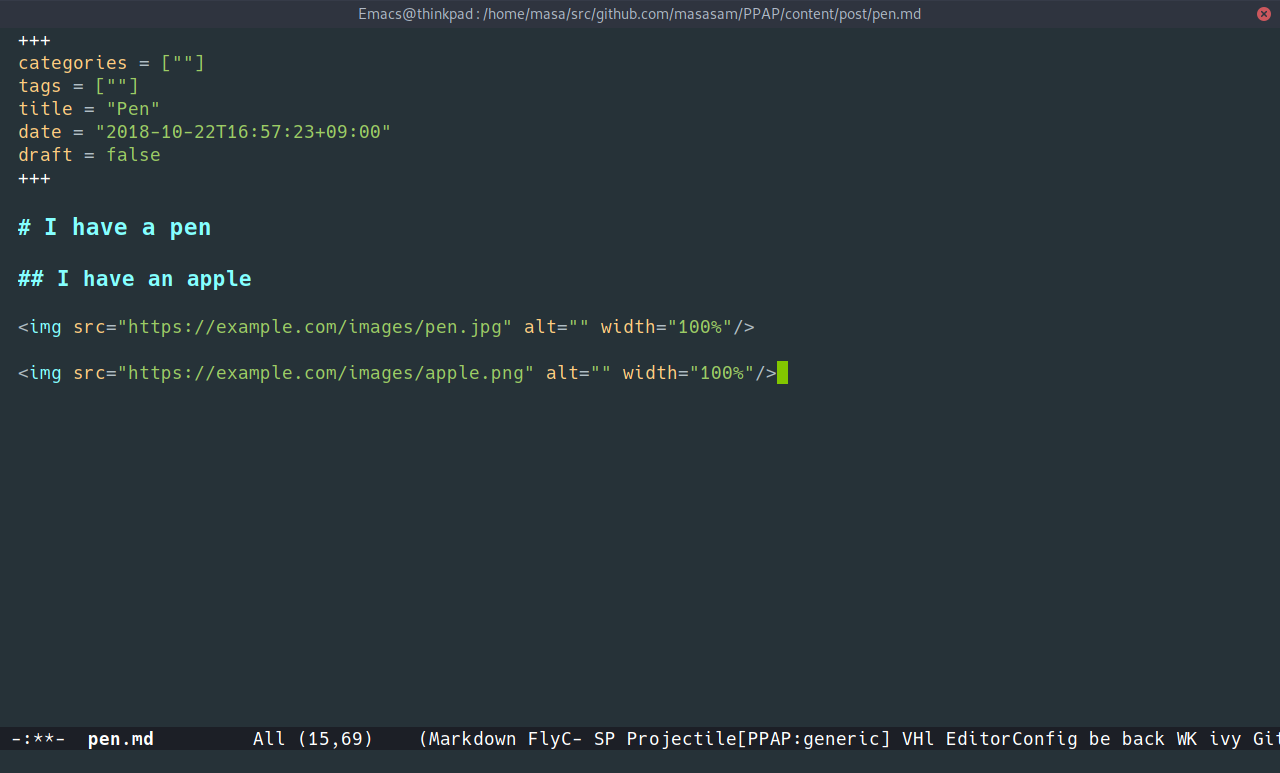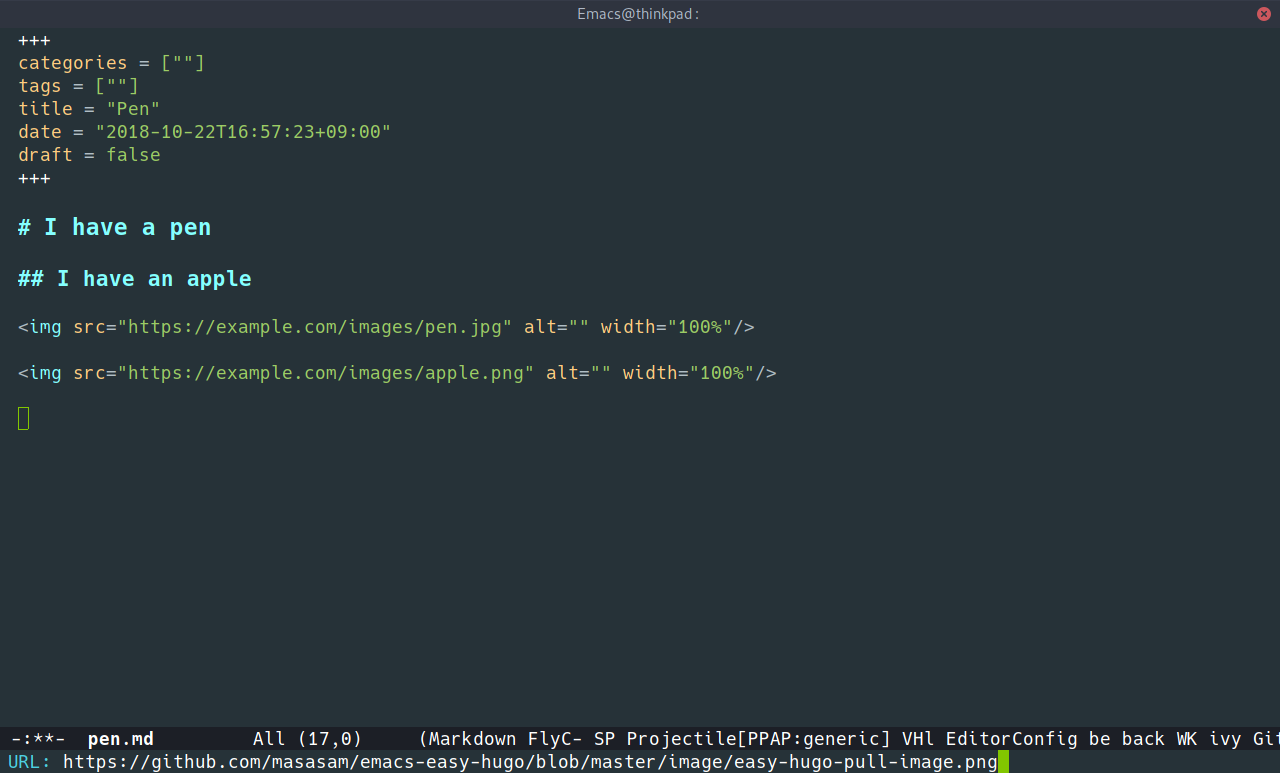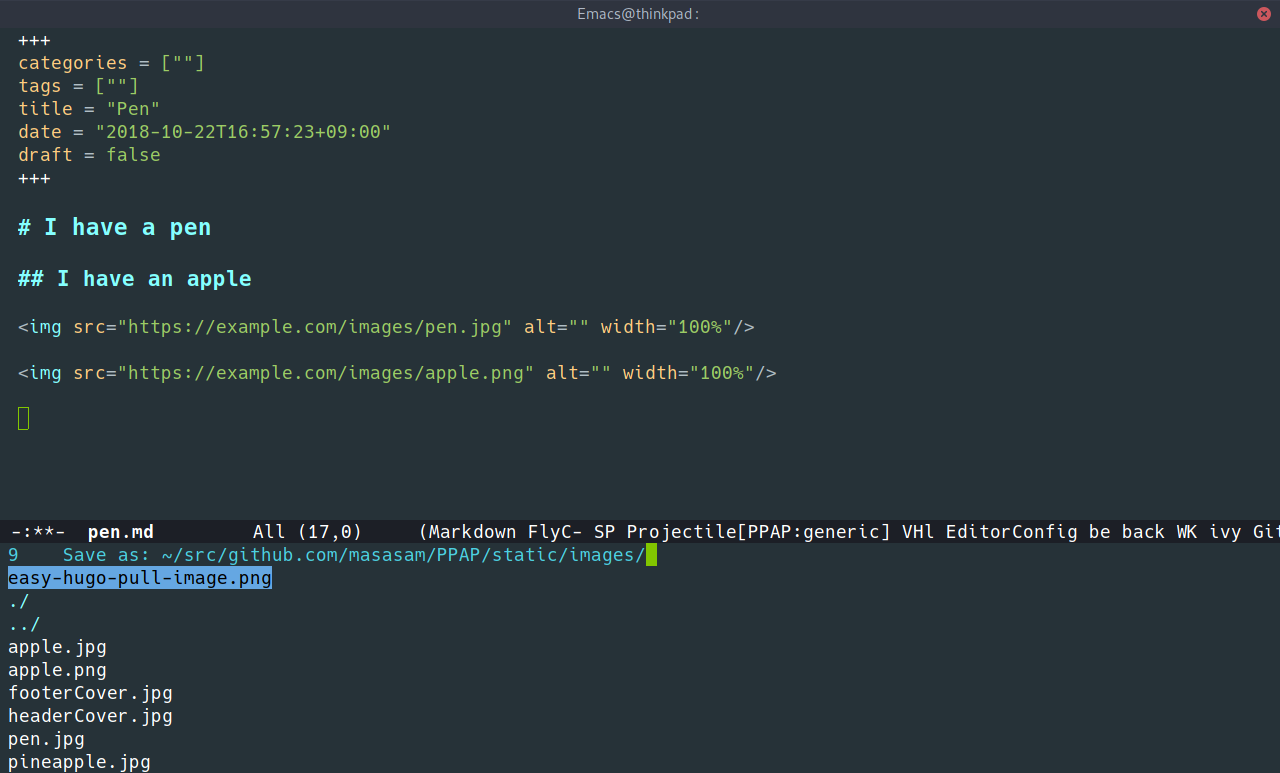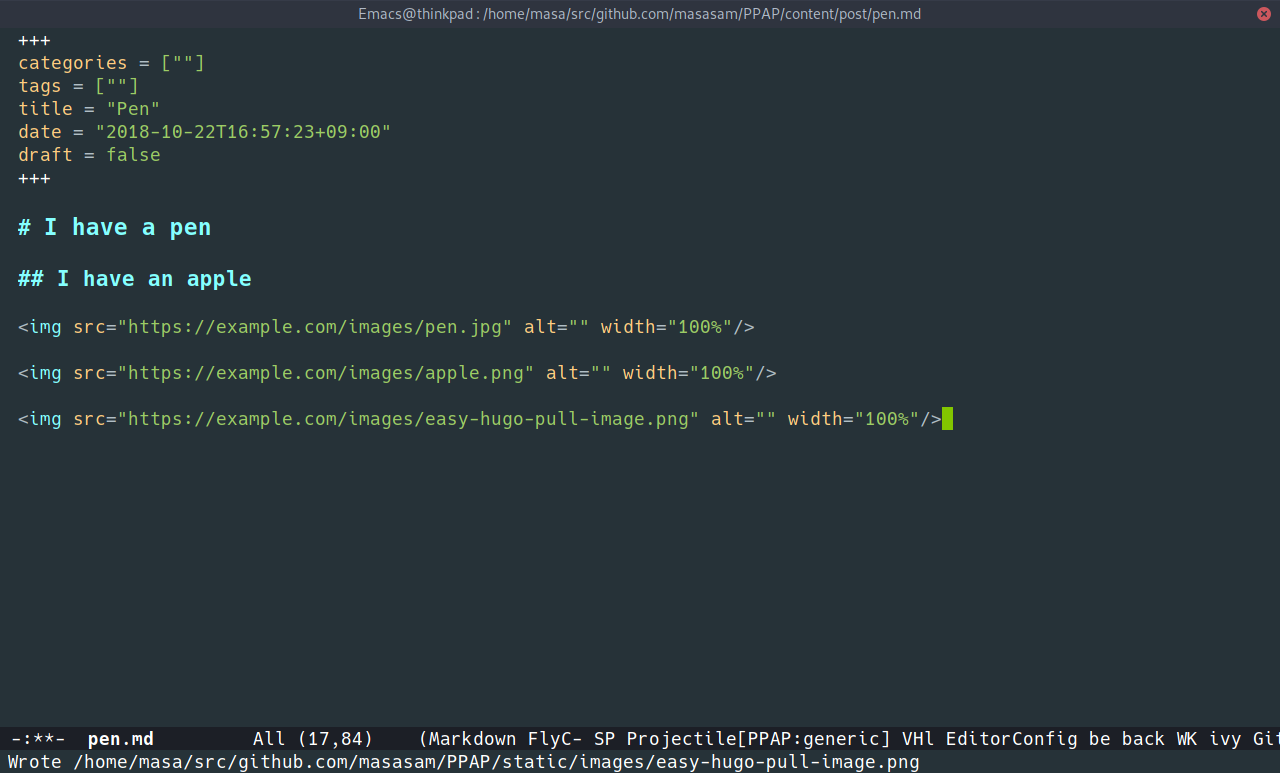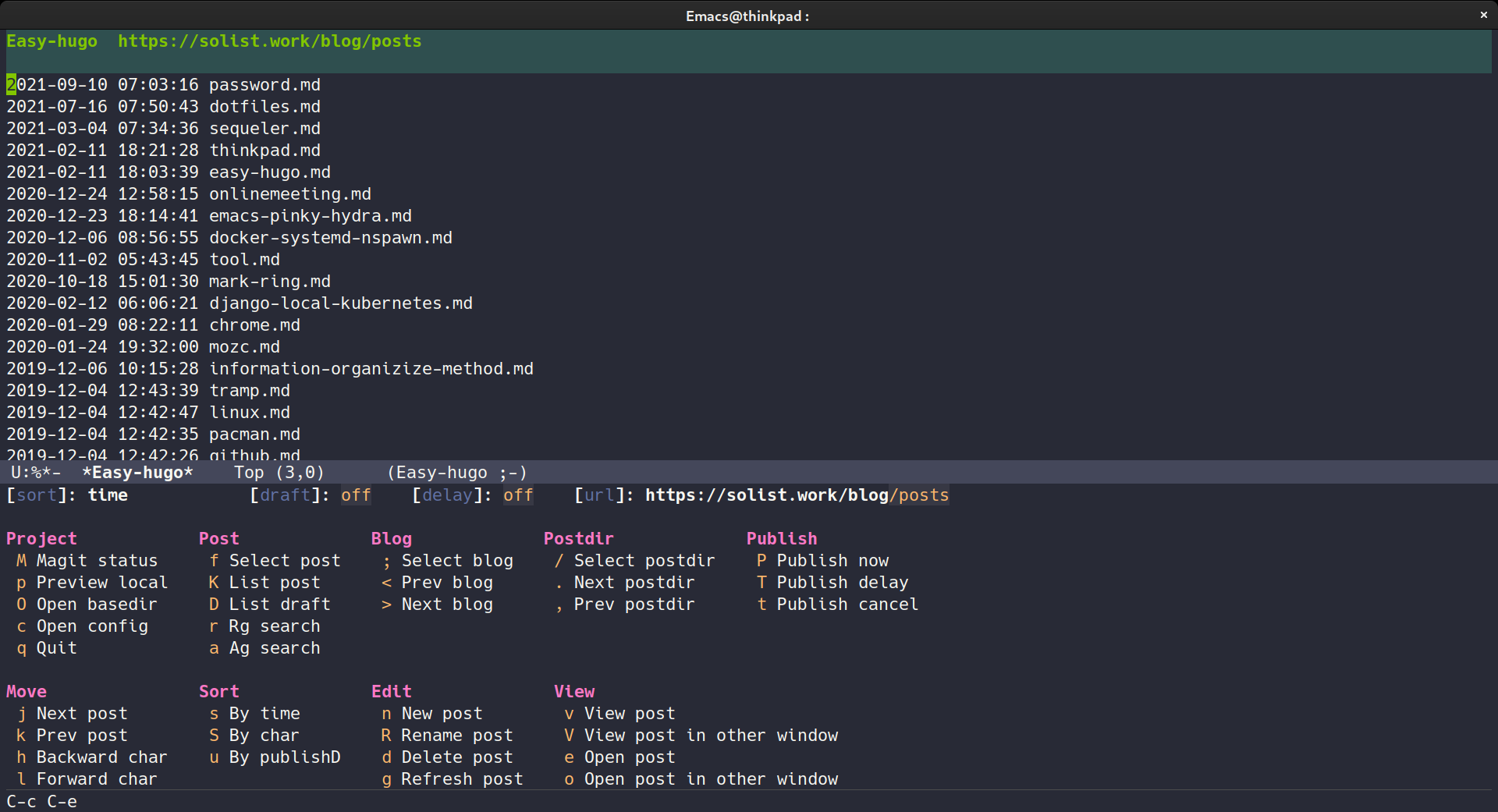easy-hugo 


Emacs major mode designed for writing Hugo-powered blogs using various markup formats, including Markdown, Org-mode, AsciiDoc, reStructuredText, mmark, and HTML. It enhances the blogging experience within Emacs, making it easier to manage and create content.
Screencast
M-x easy-hugo
You can manage blogs on easy-hugo-mode. If you manage multiple blogs, you can switch blogs with the < or > key.
M-x easy-hugo-newpost
You can post a new article. Enter a article file name in the minibuffer. A markdown file is automatically generated. You can write a blog with markdown-mode.
If you enter '.org' file name in the minibuffer, org file is automatically generated and you can write a blog with org-mode.
If you enter '.ad' file name in the minibuffer, AsciiDoc file is automatically generated and you can write a blog with AsciiDoc.
If you enter '.rst' file name in the minibuffer, reStructuredText file is automatically generated and you can write a blog with reStructuredText.
If you enter '.mmark' file name in the minibuffer, mmark file is automatically generated and you can write a blog with mmark.
If you enter '.html' file name in the minibuffer, html file is automatically generated and you can write a blog with html.
M-x easy-hugo-preview
You can preview by following the edited part. When permalinks is hugo's default and English URL, if you press p with easy-hugo-mode, it displays a preview of the article on pointer.
 (The picture of the header is http://www.pixiv.net/member_illust.php?mode=medium&illust_id=60674880)
(The picture of the header is http://www.pixiv.net/member_illust.php?mode=medium&illust_id=60674880)
The browser opens automatically and you can preview the blog on your laptop or desktop. Even if you run the easy-hugo-preview command many times, only one hugo process will run so do not mind it. Since the process of hugo running in the laptop or desktop disappears in 300 seconds, you do not have to worry about killing hugo process.
(setq easy-hugo-server-flags "-D")
Set easy-hugo-server-flags to -D in order to preview drafts.
M-x easy-hugo-publish
You can publish your blog to the server and the browser opens automatically.
M-x easy-hugo-publish-clever
Clever publish command. Automatically select the deployment destination from init.el. Only one command is executed in the following order. If easy-hugo-root is set the target blog, easy-hugo-publish will be executed. If easy-hugo-amazon-s3-bucket-name is set the target blog, easy-hugo-amazon-s3-deploy will be executed. If easy-hugo-google-cloud-storage-bucket-name is set the target blog, easy-hugo-google-cloud-storage-deploy will be executed. If the target blog has "deploy.sh" on easy-hugo-basedir, easy-hugo-github-deploy will be executed. If there is firebase command, easy-hugo-firebase-deploy will be executed.
M-x easy-hugo-ag
You can search blog article with counsel-ag or helm-ag. If both are installed, counsel-ag takes precedence at default and you can use helm-ag by writing the following to .emacs or init.el.
(setq easy-hugo-helm-ag t)
If you deploy your blog at Firebase.
M-x easy-hugo-firebase-deploy
To use easy-hugo-firebase-deploy, you make project at firebase hosting using your browser. Next run command.
npm install -g firebase-tools
cd [your-hugo-directory]
firebase login
firebase init
firebase deploy
If you deploy your blog at github etc.
M-x easy-hugo-github-deploy
Execute deploy.sh which exists in directory easy-hugo-basedir.
It is useful for hosting on GitHub Pages etc.
When you create deploy.sh with reference to hosting,
it can also correspond to various sites.
For more GitHub Pages information refer to here and here.
If you use .github/workflows/hugo.yaml, GitHub Actions will work, so you don't need deploy.sh.
M-x easy-hugo-magit
Netlify just press M and commit to GitHub. Please install Magit to use this feature.
M-x easy-hugo-amazon-s3-deploy
Deploy hugo source at Amazon S3.
M-x easy-hugo-google-cloud-storage-deploy
Deploy hugo source at Google Cloud Storage.
M-x easy-hugo-next-postdir
M-x easy-hugo-previous-postdir
With this you can go to a directory other than content/post.
M-x easy-hugo-select-filename
Select filename you want to open. You can open a selected filename article.
M-x easy-hugo-select-postdir
Select postdir you want to go. You can go to a selected directory.
M-x easy-hugo-select-blog
Select blog you want to go. You can go to a selected blog.
M-x easy-hugo-complete-tags
Auto-complete tags from your past posts.
M-x easy-hugo-complete-categories
Auto-complete categories from your past posts.
M-x easy-hugo-current-time
Generate current time in date format at the frontmatter.
M-x easy-hugo-nth-blog
You can move to a blog with the specified number.
M-x easy-hugo-image
M-x easy-hugo-figure
Generate link of image from image file directory under 'static' directory.
When you select the image file you want to use, a link will be inserted. The default for the image file directory name is "images", but if you want to change it, write as follows.
(setq easy-hugo-image-directory "img")
M-x easy-hugo-put-image
M-x easy-hugo-put-figure
Move image to 'easy-hugo-image-directory' and generate image link. You can change the initial launch position with 'easy-hugo-default-picture-directory'.
M-x easy-hugo-pull-image
M-x easy-hugo-pull-figure
Pull image from internet to image directory and generate image link. Copy the URL of the image you want to download with your browser. Execute M-x easy-hugo-pull-image.
Decide file name. If you press enter without deciding the file name, the file name can be used as it is.
The file is saved in 'easy-hugo-image-directory' and generate image link.
Commands for easy-hugo-mode
| key | function |
|---|---|
| RET | easy-hugo-open |
| Tab | easy-hugo-full-help |
| Shift-Tab | easy-hugo-no-help |
| SPC | easy-hugo-next-line |
| Shift-SPC | easy-hugo-previous-line |
| ← | easy-hugo-backward-char |
| → | easy-hugo-forward-char |
| C-b | easy-hugo-backward-char |
| C-f | easy-hugo-forward-char |
| C-n | easy-hugo-next-line |
| C-p | easy-hugo-previous-line |
| M-b | easy-hugo-backward-word |
| M-< | easy-hugo-beginning-of-buffer |
| . | easy-hugo-next-postdir |
| , | easy-hugo-previous-postdir |
| + | easy-hugo-next-postdir |
| - | easy-hugo-previous-postdir |
| / | easy-hugo-select-postdir |
| ; | easy-hugo-select-blog |
| < | easy-hugo-previous-blog |
| > | easy-hugo-next-blog |
| ? | describe-mode |
| ! | easy-hugo-cancel-firebase-deploy-timer |
| A | easy-hugo-amazon-s3-deploy |
| B | easy-hugo-firebase-deploy |
| C | easy-hugo-google-cloud-storage-deploy |
| D | easy-hugo-list-draft |
| F | easy-hugo-full-help |
| G | easy-hugo-github-deploy |
| H | easy-hugo-github-deploy-timer |
| I | easy-hugo-google-cloud-storage-deploy-timer |
| J | easy-hugo-nth-blog |
| L | easy-hugo-firebase-deploy-timer |
| M | easy-hugo-magit |
| N | easy-hugo-no-help |
| O | easy-hugo-open-basedir |
| P | easy-hugo-publish-clever |
| R | easy-hugo-rename |
| S | easy-hugo-sort-char |
| T | easy-hugo-publish-timer |
| V | easy-hugo-view-other-window |
| W | easy-hugo-amazon-s3-deploy-timer |
| a | easy-hugo-ag |
| b | easy-hugo-cancel-github-deploy-timer |
| c | easy-hugo-open-config |
| d | easy-hugo-delete |
| e | easy-hugo-open |
| f | easy-hugo-select-filename |
| g | easy-hugo-refresh |
| h | easy-hugo-backward-char |
| i | easy-hugo-cancel-google-cloud-storage-deploy-timer |
| j | easy-hugo-next-line |
| k | easy-hugo-previous-line |
| l | easy-hugo-forward-char |
| m | easy-hugo-cancel-amazon-s3-deploy-timer |
| n | easy-hugo-newpost |
| o | easy-hugo-open-other-window |
| p | easy-hugo-preview |
| q | easy-hugo-quit |
| r | easy-hugo-refresh |
| s | easy-hugo-sort-time |
| t | easy-hugo-cancel-publish-timer |
| u | easy-hugo-sort-publishday |
| v | easy-hugo-view |
| w | easy-hugo-newpost |
Requirements
- Emacs 25.1 or higher
- hugo 0.25 or higher
Installation
You can install easy-hugo.el from MELPA with package.el
(M-x package-install easy-hugo).
Confirm that PATH passes from emacs to go.
I recommend you are going to install exec-path-from-shell.
I recommend you are going to install keychain-environment.
Easy-hugo-ag needs the_silver_searcher.
Easy-hugo-ag needs counsel-ag or helm-ag.
Sample Configuration
When you change setting, you need to restart emacs.
If you deploy your blog at your server.
(setq easy-hugo-basedir "~/bookshelf/")
(setq easy-hugo-url "https://yourblogdomain")
(setq easy-hugo-sshdomain "blogdomain")
(setq easy-hugo-root "/home/blog/")
(setq easy-hugo-previewtime "300")
(define-key global-map (kbd "C-c C-e") 'easy-hugo)
If you use use-package, please write them all in :init.
(use-package easy-hugo
:init
(setq easy-hugo-basedir "~/bookshelf/")
(setq easy-hugo-url "https://yourblogdomain")
(setq easy-hugo-sshdomain "blogdomain")
(setq easy-hugo-root "/home/blog/")
(setq easy-hugo-previewtime "300")
:bind ("C-c C-e" . easy-hugo))
If you want to use transient menu style, setting as follow and then call easy-hugo-menu
;; Directly setting
(setq easy-hugo-no-help t)
(easy-hugo-enable-menu)
;; Or with use-package
(use-package easy-hugo
:bind ("C-c C-k" . easy-hugo-menu)
:config
(easy-hugo-enable-menu))If you deploy your blog at amazon s3.
(setq easy-hugo-basedir "~/bookshelf/")
(setq easy-hugo-url "https://yourblogdomain")
(setq easy-hugo-amazon-s3-bucket-name "yourS3bucketname")
If you deploy your blog at google cloud strage.
(setq easy-hugo-basedir "~/bookshelf/")
(setq easy-hugo-url "https://yourblogdomain")
(setq easy-hugo-google-cloud-storage-bucket-name "yourGCPbucketname")
If you deploy your blog at github pages etc.
(setq easy-hugo-basedir "~/bookshelf/")
(setq easy-hugo-url "https://yourid.github.io"))
If you deploy your blog at firebase hosting.
(setq easy-hugo-basedir "~/bookshelf/")
(setq easy-hugo-url "https://yourproject.firebaseapp.com")
| name | description |
|---|---|
| easy-hugo-basedir | Directory where hugo html source code is placed on your laptop or desktop |
| easy-hugo-url | Url of the blog |
| easy-hugo-sshdomain | Domain written in ~/.ssh/config |
| easy-hugo-root | Root directory of hugo at your server |
| easy-hugo-previewtime | Preview display time |
If you want to change default easy-hugo-postdir. If not set the default easy-hugo-postdir will be "content/post". Easy-hugo will not start when easy-hugo-postdir doesn't exist.
(setq easy-hugo-postdir "content/posts")
If you use Academic theme.
(setq easy-hugo-postdir "content/home")
If you want to deploy hugo at Amazon S3, please install AWS CLI and set easy-hugo-amazon-s3-bucket-name.
Please set up for with aws configure command if you are the first time aws command.
(setq easy-hugo-amazon-s3-bucket-name "your-amazon-s3-bucket-name")
If you want to deploy hugo at Google Cloud Storage, please install Google Cloud SDK and set easy-hugo-google-cloud-storage-bucket-name.
Please set up for with gcloud auth login command if you are the first time gcloud command.
(setq easy-hugo-google-cloud-storage-bucket-name "your-google-cloud-storage-bucket-name")
When writing blog with org-mode at .org file or rst-mode at .rst file or web-mode at .html file, "C-c C-e" keys are duplicated so please use other keys.
If you want the default extension to be '.org'. If not set the default extension will be '.md'.
(setq easy-hugo-default-ext ".org")
If you want the default extension to be '.ad'. If not set the default extension will be '.md'.
(setq easy-hugo-default-ext ".ad")
If you want the default extension to be '.rst'. If not set the default extension will be '.md'.
(setq easy-hugo-default-ext ".rst")
If you want to change to No help-mode from startup.
(setq easy-hugo-no-help t)
If you want to set charactor-sort at s key. If not set the default s key will be sort time.
(setq easy-hugo-sort-default-char t)
If you want to sort article in order of creation from startup.
(setq easy-hugo--sort-char-flg nil)
(setq easy-hugo--sort-time-flg nil)
(setq easy-hugo--sort-publishday-flg 1)
If you want to customise color, write the following in the init.el or .emacs.
(defface easy-hugo-help-face
`((((class color) (background light))
,@(and (>= emacs-major-version 27) '(:extend t))
:bold t
:foreground "your-hex-color"
:background "your-hex-color")
(((class color) (background dark))
,@(and (>= emacs-major-version 27) '(:extend t))
:bold t
:foreground "your-hex-color"
:background "your-hex-color"))
"Definition of help color."
:group 'easy-hugo-faces)
In order to generate link of image from image file directory under 'static' directory, if you want to change image file directory that is under 'static' directory. If not set the default image file directory will be 'images'.
(setq easy-hugo-image-directory "img")
Setting the picture directory of your laptop or desktop, it is easy to execute M-x easy-hugo-put-image.
(setq easy-hugo-default-picture-directory "~/Pictures")
If you want to use org style header, set it as below.
(setq easy-hugo-org-header t)
Then it becomes the following header. If you want to expand its keywords, use either #+KEY: VALUE format to set a single value string or #+KEY[]: VALUE_1 VALUE_2 format to assign multiple values in a whitespace-separated list of strings.
#+TITLE: filename
#+DATE: 2018-01-31T12:10:08-08:00
#+DRAFT: nil
#+CATEGORIES[]: nil nil
#+TAGS[]: nil nil
#+DESCRIPTION: Short description
Multiple blogs setting
When you change setting, you need to restart emacs.
;; Main blog
(setq easy-hugo-basedir "~/bookshelf/")
(setq easy-hugo-url "https://yourblogdomain")
(setq easy-hugo-sshdomain "blogdomain")
(setq easy-hugo-root "/home/blog/")
(setq easy-hugo-previewtime "300")
(define-key global-map (kbd "C-c C-e") 'easy-hugo)
(setq easy-hugo-bloglist
;; blog2 setting
'(((easy-hugo-basedir . "~/src/github.com/masasam/hugo2/")
(easy-hugo-url . "http://example2.com")
(easy-hugo-sshdomain . "myblogdomain")
(easy-hugo-root . "/home/hugo/"))
;; blog3 setting for aws s3
((easy-hugo-basedir . "~/src/github.com/masasam/hugo3/")
(easy-hugo-url . "http://example3.net")
(easy-hugo-amazon-s3-bucket-name . "yourS3bucketname"))
;; blog4 setting for google cloud strage
((easy-hugo-basedir . "~/src/github.com/masasam/hugo4/")
(easy-hugo-url . "http://example4.net")
(easy-hugo-google-cloud-storage-bucket-name . "yourGCPbucketname")
(easy-hugo-image-directory . "img"))
;; blog5 setting for github pages
((easy-hugo-basedir . "~/src/github.com/masasam/githubpages/")
(easy-hugo-url . "https://yourid.github.io"))
;; blog6 setting for firebase hosting
((easy-hugo-basedir . "~/src/github.com/masasam/firebase/")
(easy-hugo-url . "https://yourproject.firebaseapp.com"))))
If you use use-package, please write them all in :init.
(use-package easy-hugo
:init
;; Main blog
(setq easy-hugo-basedir "~/bookshelf/")
(setq easy-hugo-url "https://yourblogdomain")
(setq easy-hugo-sshdomain "blogdomain")
(setq easy-hugo-root "/home/blog/")
(setq easy-hugo-previewtime "300")
(define-key global-map (kbd "C-c C-e") 'easy-hugo)
(setq easy-hugo-bloglist
;; blog2 setting
'(((easy-hugo-basedir . "~/src/github.com/masasam/hugo2/")
(easy-hugo-url . "http://example2.com")
(easy-hugo-sshdomain . "myblogdomain")
(easy-hugo-root . "/home/hugo/"))
;; blog3 setting for aws s3
((easy-hugo-basedir . "~/src/github.com/masasam/hugo3/")
(easy-hugo-url . "http://example3.net")
(easy-hugo-amazon-s3-bucket-name . "yourS3bucketname"))
;; blog4 setting for google cloud strage
((easy-hugo-basedir . "~/src/github.com/masasam/hugo4/")
(easy-hugo-url . "http://example4.net")
(easy-hugo-google-cloud-storage-bucket-name . "yourGCPbucketname")
(easy-hugo-image-directory . "img"))
;; blog5 setting for github pages
((easy-hugo-basedir . "~/src/github.com/masasam/githubpages/")
(easy-hugo-url . "https://yourid.github.io"))
;; blog6 setting for firebase hosting
((easy-hugo-basedir . "~/src/github.com/masasam/firebase/")
(easy-hugo-url . "https://yourproject.firebaseapp.com"))))
:bind ("C-c C-e" . easy-hugo))
You can manage as many blogs as you like.
If you want to change markdown filename extension, please select md or markdown or mdown. Because only these three are supported by hugo. If not set markdown filename extension will be 'md'.
(setq easy-hugo-markdown-extension "markdown")
If you want to change asciidoc filename extension, please select ad or asciidoc or adoc. Because only these three are supported by hugo. If not set asciidoc filename extension will be 'ad'.
(setq easy-hugo-asciidoc-extension "asciidoc")
If you want to change html filename extension, please select html or htm. Because only these two are supported by hugo. If not set html filename extension will be 'html'.
(setq easy-hugo-asciidoc-extension "htm")
For spacemacs or evil-mode users
If you use spacemacs or evil-mode, see spacemacs-easy-hugo.
Support emacspeak
If you use easy-hugo with emacspeak.
(setq easy-hugo-emacspeak t)
Preparation for using this package
Install hugo See https://gohugo.io/
Quickstart Guide See https://gohugo.io/overview/quickstart/
Configuration file example
hugo.toml
hasCJKLanguage = true
theme="material-design"
baseurl = "https://example.com"
languageCode = "ja"
title = "PPAP blog"
MetaDataFormat = "toml"
paginate = 9
copyright = "© 2017 PPAP blog powered by Hugo"
[params]
blogurl = "https://example.com"
blogdomain = "example.com"
github = "your github user name"
twitter = "your twitter user name"
googleAnalyticsUserID = "UA-************"
archetypes/default.md
+++
categories = [""]
tags = [""]
title = "{{ replace .TranslationBaseName "-" " " | title }}"
date = "{{ .Date }}"
draft = false
+++
archetypes/default.org (If your hugo version is 0.25 or higher)
+++
categories = [""]
tags = [""]
title = "{{ replace .TranslationBaseName "-" " " | title }}"
date = "{{ .Date }}"
draft = false
+++
archetypes/default.ad
+++
categories = [""]
tags = [""]
title = "{{ replace .TranslationBaseName "-" " " | title }}"
date = "{{ .Date }}"
draft = false
+++
archetypes/default.rst
+++
categories = [""]
tags = [""]
title = "{{ replace .TranslationBaseName "-" " " | title }}"
date = "{{ .Date }}"
draft = false
+++
archetypes/default.mmark
+++
categories = [""]
tags = [""]
title = "{{ replace .TranslationBaseName "-" " " | title }}"
date = "{{ .Date }}"
draft = false
+++
archetypes/default.html
+++
categories = [""]
tags = [""]
title = "{{ replace .TranslationBaseName "-" " " | title }}"
date = "{{ .Date }}"
draft = false
+++
Prepare the server
Let's build with a free trial of "google compute engine" or "amazon ec2". If you want deploy hugo at GitHub Pages or Amazon S3 or Google Cloud Storage, This paragraph is not necessary. I created my blog in google compute engine. Check if rsync is installed on the server.
Write at ~/.ssh/config on your laptop or desktop.
Host blogdomain
HostName "Your server's IP"
User "Your server's ssh login username"
Because blog is generated under /home/blog/ on the server, set it to reference it with nginx. SSL uses certbot (Let's encrypt).
sample nginx.conf
server {
listen 80;
server_name yourdomain;
return 301 https://yourdomain$request_uri;
location / {
root /home/blog;
index index.html index.htm;
}
}
server {
listen 443;
server_name yourdomain;
ssl on;
ssl_certificate /etc/letsencrypt/live/yourdomain/fullchain.pem;
ssl_certificate_key /etc/letsencrypt/live/yourdomain/privkey.pem;
location / {
root /home/blog;
index index.html index.htm;
}
}
PPAP source sample for hugo.



